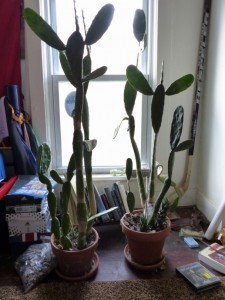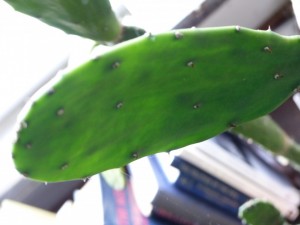Prickly pear cactus. A quiet, well-behaved plant, as house-plants go. These guys have been living meekly in their pots for more than twenty years—just getting taller and taller. They’re in an upstairs room, and I keep forgetting to water them, and every six months or so I go upstairs with a watering pot, fully expecting to find shriveled corpses. But prickly pear is a plant that’s hard to kill.
This spring, I decided to take pity on the poor things and let them enjoy a pleasant summer soaking up the sun on the front porch. As I maneuvered one of the lanky plants down the stairs and out the door, I unwarily brushed against the thorns and –nothing happened. At first.
Prickly pear is a cactus with two kinds of thorns, big and little. The big ones can poke you, but no big deal, really. The little thorns are almost invisible, covering parts of the plant like fur, looking soft and silky. Easy to ignore. They’re called glochids.
These little glochids, when magnified under a microscope, are barbed like arrows. At the lightest touch they leap free of the cactus as if shot from a bow, and embed themselves in your skin. They’re practically impossible to get rid of. Ah, yes, the prickly pear had a satisfying revenge for all those unwatered months.
In its natural desert habitat, prickly pear doesn’t stay neatly within the bounds of a flowerpot. It spreads and sprawls across the earth, looking like fat green dishes balanced on top of each other. Every time the pile collapses and a dish touches the ground, it takes root almost instantly, sprouting with enthusiasm. You can even rip off one of the round, flat pads, stick it in the ground and quickly grow a whole new plant.
Prickly pear is native to the New World, and is a part of the diverse landscape of cacti that make the American desert such a memorable place. In its original habitat, prickly pear is one of many species, and its juicy and nutritious fruit is eaten by many types of wildlife, and–very carefully–by humans.
A docile and useful plant, and in fact it seemed, in the eighteenth century, as though prickly pear would be a perfect plant to import to the outback of Australia. Surely prickly pear would find a happy home in such a dry and deserty environment. Not much else was growing there, so why not try out a new species? Its prickliness made it a natural living fence for livestock—perfect for farmers!–and it even had tasty fruit.
I’m sure you can guess where this is going. Take a barren desert environment, and add a plant that grows prolifically, easily spreads, and is all but impossible to touch. Soon hundreds, then thousands, then millions of acres of Australia were invaded by prickly pear.
But this wasn’t like an invasion of dandelions on your lawn. Prickly pear spread like a virus, making whole farms uninhabitable. The spiny snarl of cactus became twenty feet high in places. Houses and barns were crushed beneath the weight of the plants. Impoverished farmers gave up and fled the “green hell.”
Fortunately, this was in the early 1900s, before it was possible to spray DDT or some other wild-life-destroying herbicide over the entire country. Prickly pear was finally tamed biologically, by the introduction of a moth that ate it. Now, while not eradicated completely, it’s not the spiky, ecosystem-destroying menace it once was.
Just goes to show. It’s the quiet ones you have to look out for.





Even people with brown thumbs can grow prickly pears (Opuntias). There are dozens of varieties to choose from. Short. Tall. Wide. Narrow. I put my plants outdoors on the porch in summer and they are happy as can be. In the fall I bring them in and mostly don’t water them. They sit dormant in my living room window.
Thanks for the article. It makes me appreciate my plants all over again.
Joe
https://www.opuntiads.com/
Thanks! I love your website. My goal is to get my cacti to flower!
LOL – more power to the quiet ones! Wouldn’t think a moth would keep it under control! That’s so cool! And coincidentally – I’m in the middle of reading Bill Bryson’s “In a Sunburned Country” – about Australia! Love your posts!
thanks for sharing!